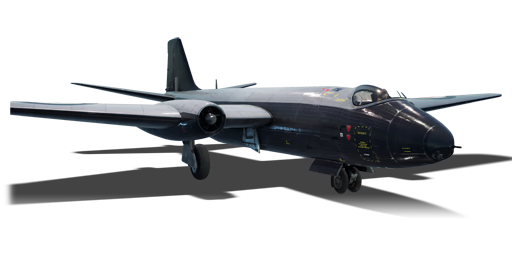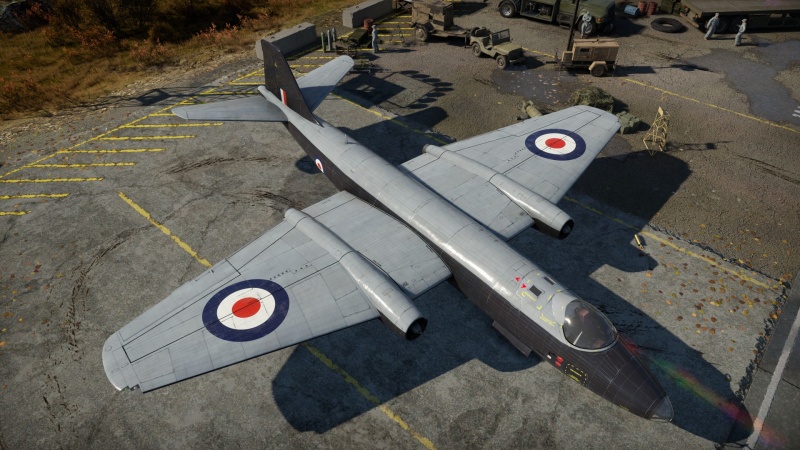Difference between revisions of "Canberra B Mk 2"
| Line 58: | Line 58: | ||
! Combat !! Take-off !! Landing !! + !! - | ! Combat !! Take-off !! Landing !! + !! - | ||
|- | |- | ||
| − | | {{Specs|destruction|body}} | + | | {{Specs|destruction|body}} || {{Specs|destruction|gear}} || 498 || 469 || 320 || ~7 || ~3 |
|- | |- | ||
|} | |} | ||
| Line 174: | Line 174: | ||
;Skins | ;Skins | ||
| − | |||
* [https://live.warthunder.com/feed/camouflages/?vehicle=canberra_bmk2 Skins and camouflages for the {{PAGENAME}} from live.warthunder.com.] | * [https://live.warthunder.com/feed/camouflages/?vehicle=canberra_bmk2 Skins and camouflages for the {{PAGENAME}} from live.warthunder.com.] | ||
| Line 183: | Line 182: | ||
;Related development | ;Related development | ||
| − | |||
* [[Canberra (Family)]] | * [[Canberra (Family)]] | ||
Revision as of 06:58, 31 March 2022
| This page is about the British jet bomber Canberra B Mk 2. For other versions, see Canberra (Family). |
Contents
Description
The Canberra B Mk 2 is a rank British jet bomber with a battle rating of (AB), (RB), and (SB). It was introduced in Update 1.43.
General info
Flight performance
| Characteristics | Max Speed (km/h at 3,000 m) |
Max altitude (metres) |
Turn time (seconds) |
Rate of climb (metres/second) |
Take-off run (metres) | |||
|---|---|---|---|---|---|---|---|---|
| AB | RB | AB | RB | AB | RB | |||
| Stock | 835 | 809 | 26.9 | 27.6 | 14.8 | 13.4 | 750 | |
| Upgraded | 915 | 880 | 25.4 | 26.0 | 25.7 | 20.0 | ||
Details
| Features | |||||
|---|---|---|---|---|---|
| Combat flaps | Take-off flaps | Landing flaps | Air brakes | Arrestor gear | Drogue chute |
| ✓ | ✓ | ✓ | ✓ | X | X |
| Limits | ||||||
|---|---|---|---|---|---|---|
| Wings (km/h) | Gear (km/h) | Flaps (km/h) | Max Static G | |||
| Combat | Take-off | Landing | + | - | ||
| 498 | 469 | 320 | ~7 | ~3 | ||
| Optimal velocities (km/h) | |||
|---|---|---|---|
| Ailerons | Rudder | Elevators | Radiator |
| < 590 | < 550 | < 500 | N/A |
Engine performance
| Engine | Aircraft mass | |||||||
|---|---|---|---|---|---|---|---|---|
| Engine name | Number | Empty mass | Wing loading (full fuel) | |||||
| Rolls-Royce Avon Mk.101 | 2 | 10,300 kg | 171 kg/m2 | |||||
| Engine characteristics | Mass with fuel (no weapons load) | Max Takeoff Weight | ||||||
| Weight (each) | Type | 15m fuel | 20m fuel | 30m fuel | 45m fuel | 50m fuel | ||
| 800 kg | Axial-flow turbojet | 11,800 kg | 12,280 kg | 13,240 kg | 14,680 kg | 15,160 kg | 20,865 kg | |
| Maximum engine thrust @ 0 m (RB/SB) | Thrust to weight ratio @ 0 m (100%) | |||||||
| Condition | 100% | WEP | 15m fuel | 20m fuel | 30m fuel | 45m fuel | 50m fuel | MTOW |
| Stationary | 2,850 kgf | N/A | 0.48 | 0.46 | 0.43 | 0.39 | 0.38 | 0.27 |
| Optimal | 2,850 kgf (0 km/h) |
N/A | 0.48 | 0.46 | 0.43 | 0.39 | 0.38 | 0.27 |
Survivability and armour
- No armour plating
- No armour glazing
- Critical components located at the fuselage of the aircraft (fuel, pilot, controls)
- Engines in wings
Modifications and economy
Armaments
Suspended armament
The Canberra B Mk 2 can be outfitted with the following ordnance:
- 9 x 500 lb H.E. M.C. Mk.II bombs (4,500 lb total)
- 6 x 1,000 lb H.E. M.C. Mk.13 bombs (6,000 lb total)
- 1 x H.C. 4,000 lb Mk.II bomb + 2 x 1,000 lb H.E. M.C. Mk.13 bombs (6,000 lb total)
Usage in battles
Climbing high to around 10 kilometres will save you from most predators and AA fire in both AB and RB as the Canberra has one of the best climb rates and high-alt performances in the game. Watch out for the Me 163 and Ki-200, who can climb to you easily thanks to their Rocket Engines. A common strategy by Canberras (and B-57s, as they are the same airframe) is to head to one base, drop all payload on such base and then running for their lives. Using the 6 x 1,000 lb payload is recommended for usage on bases while 1 x 4,000 lb + 2 x 1,000 lb payload works best when used on airfields.
Pros and cons
Pros:
- Good stock engine power
- Good stock acceleration speed
- Powerful airbrakes
- Good top speed for such a large aircraft
- Decent payload
- High service ceiling(max. altitude)
- Great climb rate
Cons:
- May rip wings by going straight for a while without intelligent use of air-brakes
- Likely to be a big target for fighter aircraft with an air-spawn and be engaged first.
- Slower than most fighters, which means you will be caught up by all jets that chase you
- An easy target for anything with guns that can go over 800 km/h
- First few fights will be running to a base, bombing the base and ending up dead by enemy jets.
History
The Canberra B Mk.2 was created in 1949 to replace the Mosquito fast bomber. It was designed to have outstanding high altitude performance and speed, being unparalleled for 10 years. Despite the RAF originally expecting the Canberra to be obsolete within a few years of entering service, so much so that work to develop a replacement (eventually leading to the TSR-2) was started before it had even entered service, it would go on to be one of the RAF's longest serving aircraft. The Canberra remined in front line service with the RAF until its retirement in 2006, some 55 years after it first entered service (although it spent a lot of that time in the photo-reconnaissance role, as opposed to its original purpose as a bomber). The Canberra was replaced in the strategic bomber role by the Valiant (and other V-bombers), and in the strike role by the Buccaneer (following the cancellation of the TSR-2 programme). It established a world altitude record of 21,430 m in 1957 and was the first jet-powered aircraft to make a non-stop transatlantic flight.
In-game description
Whilst the United States and the Soviet Union were, in many ways, running ahead of Britain during the early development of jet fighters, Britain would at least keep up if not forge ahead with its very first jet bomber – the legendary English Electric Canberra.
The origins of the Canberra lay in 1944 when the Air Ministry called for a replacement for the de Havilland Mosquito in the light bomber role – a fast, agile tactical bomber was required by RAF Bomber Command to move into the jet age. English Electric set to work under Chief Engineer WEW Petter, who envisaged a bomber built around straight wings of a large area, and two of the new Rolls-Royce Avon jet engines. The prototype first flew in May 1949, with Typhoon-ace Roland Beamont at the controls. The Chief Test Pilot remarked that the aircraft was practically free of vices and possessed an agility that was reminiscent of a fighter rather than a bomber.
After various modifications were made, including the addition of a glass nose for a bomb aimer, the first production variant – the B Mk.2 - entered service in 1951 with No.101 Squadron. The Canberra was able to reach speeds of some 560 mph and reach heights of 48,000 feet whilst maintaining the capacity to carry 6000 lbs of ordnance. A series of modified Canberra B Mk.2s set a succession of world altitude records, culminating in August 1957 with a staggering 70,310 feet. It was a Canberra that saw victory at the Last Great Air Race from London to Christchurch in 1953. With a range of approximately 2600 miles, the Canberra was considered a tactical rather than a strategic bomber.
The Canberra was popular with its aircrew due to its performance, popular with ground crews due to its relatively simple maintenance schedule and also popular with Command due to its relatively low cost. Over 400 Canberra B Mk.2's were built until uprated engines led to the development of its successor, the B Mk.6, which entered service in the summer of 1954. As squadrons received the newer model, the now older B Mk.2 saw service with the RAF in Germany, Cyprus and the Far East, although the variant did serve successfully in the Suez Crisis of 1956. A small number of export variants of the B Mk.2 also saw service with the United States as a template for building under license as the Martin B-57, Australia and Venezuela.
Media
- Skins
See also
- Related development
External links
| The English Electric Company Limited | |
|---|---|
| Jet Fighters | Lightning F.6 · Lightning F.53 |
| Jet Bombers | Canberra B Mk 2 · Canberra B (I) Mk 6 |
| Tanks | Excelsior |
| The English Electric Company allowed the Glenn L. Martin Company to license-build Canberra bombers for the United States Air Force. | |
| Britain jet aircraft | |
|---|---|
| Blackburn | Buccaneer S.1 · Buccaneer S.2 · Buccaneer S.2B |
| British Aerospace | Harrier GR.7 · Sea Harrier FRS.1 (e) · Sea Harrier FRS.1 · Sea Harrier FA 2 |
| British Aircraft Corporation | Strikemaster Mk.88 |
| English Electric | Canberra B Mk 2 · Canberra B (I) Mk 6 · Lightning F.6 · Lightning F.53 |
| Gloster | Meteor F Mk 3 · Sea Meteor F Mk 3 · Meteor F Mk 4 G.41F · Meteor F Mk 4 G.41G · Meteor F Mk 8 G.41K · Meteor F Mk.8 Reaper |
| Javelin F.(A.W.) Mk.9 | |
| de Havilland | Vampire F.B.5 · Venom FB.4 · Sea Venom FAW 20 · Sea Vixen F.A.W. Mk.2 |
| Hawker | Sea Hawk FGA.6 · Hunter F.1 · Hunter F.6 · Hunter FGA.9 · Harrier GR.1 · Harrier GR.3 |
| Panavia | Tornado GR.1 · Tornado GR.4 · Tornado F.3 · Tornado F.3 Late |
| SEPECAT | Jaguar GR.1 · Jaguar GR.1A · Jaguar IS |
| Supermarine | Attacker FB 1 · Attacker FB.2 · Scimitar F Mk.1 · Swift F.1 · Swift F.7 |
| Foreign | Phantom FG.1 (USA) · Phantom FGR.2 (USA) · F-4J(UK) Phantom II (USA) |
| Australia | F-111C |
| India | ▄MiG-21 Bison |
| South Africa | ▄JAS39C |





